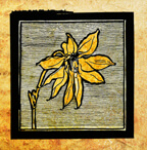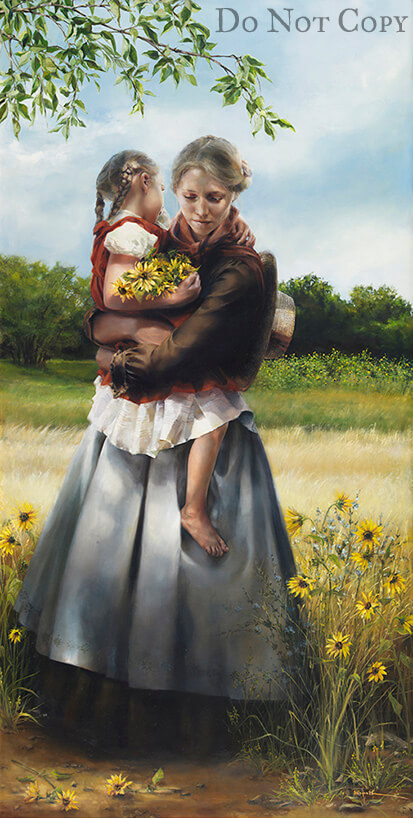“Blessed Honored Pioneer”
{ Lucinda Strickland Pace }
Painted by Elspeth Young
« Previous Painting • Next Painting »
I will mention the lovingkindnesses of the Lord...and the great goodness toward the house of Israel, which he hath bestowed on them according to his mercies, and according to the multitude of his lovingkindnesses...
In all their affliction he was afflicted, and the angel of his presence saved them: in his love and in his pity he redeemed them; and he bare them, and carried them all the days of old.
The story behind Blessed Honored Pioneer
In 1842, Lucinda received a patriarchal blessing from Hyrum Smith in which she was commended for the integrity of her heart. Her family also described her as highly educated, sensitive, refined, and capable. Her unwavering faith in God enabled her to sacrifice willingly and without complaint throughout the many hardships she faced. For example, throughout the three missions to which her husband, James, was called—in addition to serving 18 months in the Mormon Batalion—Lucinda cared for their children while also working to provide necessities for the family.
The painting, in addition to presenting one of the founders of Payson, Utah, is an allegorical representation of the pioneering experience of the many thousands of immigrants who participated in the westward migration of The Church of Jesus Christ of Latter-day Saints (1847-1868) and for whom the House of the Lord was the centerpiece of their devotion.
Lucinda is depicted carrying one of her daughters, which is, essentially, what pioneers do: From one generation to the next, it is the privilege of pioneers to carry future generations in their arms. The daughter, safe in Lucinda's grasp, is barefooted, just as every rising generation is barefooted upon confronting the perils in this world. Evidently, the child has been gathering sunflowers—carefree in the boundless sunshine of a summer day.
Some of the sunflowers, however, in the fullness of their bloom, have fallen onto the path. And while the child cradles the promise of the future in her arms and gazes into the distance, Lucinda is mindful of loved ones fallen by the wayside. There is also a great throng of sunflowers that have been left behind, like so many multitudes of wonderful people who are kept from the hope of a better world only because they know not where to find it.
Thus are met—in the composition of this painting—not only the past, the present, and the future, but the multitudes of people who belong to them; met as they meet in the only place on earth where there is power to heal all of them: The House of the Lord.
Symbolism in Blessed Honored Pioneer
Sunflowers appearing in the painting (Helianthus anomalus) are native to Utah and are frequently mentioned in early pioneer accounts. Their use in the painting was inspired not only because of historical accuracy, but by a quote from Willa Cather, written in 1918, presenting the sunflower as a symbol of hope:
Sometimes I followed the sunflower-bordered roads. [A friend] told me that the sunflowers were introduced into that country by the Mormons; that at the time of the persecution, when they left Missouri and struck out into the wilderness to find a place where they could worship God in their own way, the members of the first exploring party, crossing the plains to Utah, scattered sunflower seed as they went. The next summer, when the long trains of wagons came through with all the women and children, they had the sunflower trail to follow...that legend has stuck in my mind, and sunflower-bordered roads always seem to me the roads to freedom. (From My Antonia, 1918.)A cottonwood tree (Populus fremontii), a species frequently mentioned in Mormon trail diaries, shades the two figures from the noonday sun. The willow and cottonwood trees in the distance are also native along the Mormon Trail. Tall prairie grasses like Prarie Dropseed (Sporobolus heterolepsis), Great Basin Wildrye (Leymus cinereus), and chicory (Cichorium intybus), painted behind and around the figures, were common all along the Mormon Trail. Such grasses are also frequently mentioned in early accounts of the trek.
Lucinda wears a homespun kerchief over a traditional American work dress topped by a decorative apron in a traditional star pattern. Such embroidered or even painted aprons were frequently worn. A simple straw hat temporarily hanging off her back finishes this traditional frontier costume. This costume silhouette closely echoes renderings by C.C.A. Christensen, who carefully cataloged costumes worn by Mormon women crossing the plains. Lucinda’s hairstyle is dressed in a simple twist and braided chignon, a style typical of the era.
Lucinda’s daughter wears a traditional frock dress, covered by a red pinafore, ubiquitous in children’s costuming on the American frontier at that time. The child’s hair is dressed in simple pigtail braids, also common to the era. Because of continued poverty, many pioneers (particularly small children) who made the trek in the 1840s and 50s walked barefoot to the Valley of the Great Salt Lake and remained barefoot for some time even after establishing homes.
Copyright and terms of use
© By Intellectual Reserve, Inc. You may not print, copy, or reproduce this artwork or make derivative works from it without the prior written consent of the copyright holder. Al Young Studios cannot make or sell any prints of this artwork at this time. Read more...From the Newsroom

By Al R. Young
only high-end custom frames
We have framed our own artworks for more than 30 years, and during that time we have provided a variety of framing services to patrons upon request. For many reasons—including constant changes in the availability of moulding styles—we cannot offer off-the-shelf framing options or response times typically associated with such a service. Of necessity, all of our framing projects are aproached, priced, and billed as constuling projects... Read more »
Tags: Into The West, Spring Rain, North Country, The Grey Havens, Journey's End, Looking Back, Enchanted Stillness, Bedtime Story, In The High Valley, The Daydream, Before The Ball, Old Shannon, Pavane, Sweet Brier, Legend, Mountain Home, And I...

By Elspeth C. Young
content for this page is being prepared and will be added as soon as possible
2021 November 05... Read more »
Tags: Blessed Honored Pioneer, 2021, Oil paintings and prints, Temple artworks

By Al R. Young Blessed Honored Pioneer is the newest oil painting to be added to the line of original artworks from Al Young Studios.
Click here to see a larger image of the new painting, read the artist's commentary, and look at the selection of prints--if any are available.... Read more »
Tags: Blessed Honored Pioneer, 2015, Elspeth C. Young, Legacy, News, Oil paintings and prints, Pioneer Art Collection